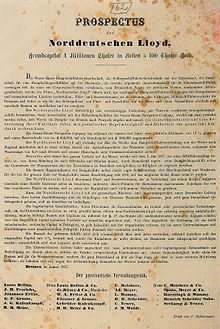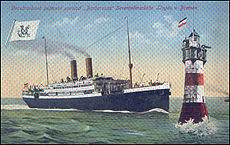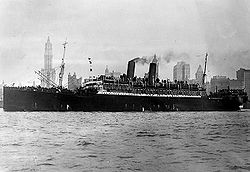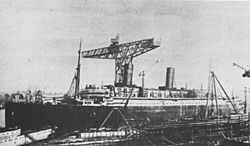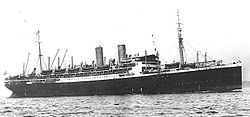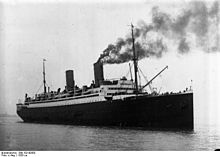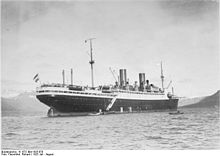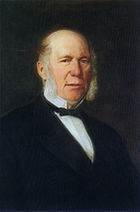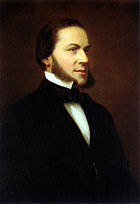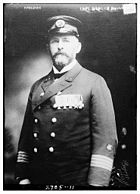- Norddeutscher Lloyd
-
Norddeutscher Lloyd 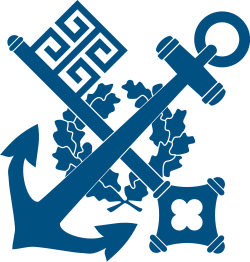
Logo of NDLType Joint stock company Genre Shipping Fate Merged with Hamburg America Line in 1970 Predecessor Ocean Steam Navigation Company Successor Hapag-Lloyd Founded 1857 in Bremen, Germany Founder(s) Hermann Henrich Meier Area served Transatlantic, Mediterranean, Asia, and Australia Key people Co-founder and Executive Chairman
Eduard CrüsemannNorddeutsche Lloyd (NDL) (North German Lloyd) was a German shipping company. It was founded by Hermann Henrich Meier[1] and Eduard Crüsemann in Bremen on February 20, 1857. It developed into one of the most important German shipping companies of the late 19th and early 20th centuries, and was instrumental in the economic development of Bremen and Bremerhaven. On September 1, 1970, the company merged with Hamburg America Line (HAPAG) to form Hapag-Lloyd AG.[2]
Contents
History
Establishment of the NDL
The German shipping company North German Lloyd (NDL) was founded by the Bremen merchants Hermann Henrich Meier and Eduard Crüsemann on February 20, 1857, after the dissolution of the Ocean Steam Navigation Company, a joint German-American enterprise.[3] The new shipping company had no association with the British maritime classification society Lloyd's Register;[4] in the mid-19th century, "Lloyd" was used as a term for shipping.H.H. Meier[5] became NDL's first Chairman of the Supervisory Board, and Crüsemann became the first director of the company (German: Aktiengesellschaft - AG). Crüsemann was in charge of both cargo services and passenger transport, which, as a result of emigration, was growing significantly. The company was also active in other areas, including tugboats, bathing, insurance, and ship repair (the last of which it still provides). The first office of the shipping company was located at number 13 Martinistraße in Bremen.
The company started with a route to England prior to starting a transatlantic service. In 1857, the first ship, the Adler (Eagle), began regular passenger service between the Weser region (where Bremen is located) and England. On October 28, 1857, it made its maiden voyage from Nordenham to London.[6]
Just one year later, regular, scheduled services were started between the new port in Bremerhaven and New York using two 2,674 GRT steamships, the Bremen and the New York. During the succeeding years, passenger connections to Baltimore and New Orleans were added to the schedule. International economic crises made the start of the NDL extremely difficult, and the company took losses until 1859.[6]
In 1867-1868, NDL began a partnership with the Baltimore and Ohio Railroad, which initiated the Baltimore Line; until 1978, this had its own ships. In 1869, Crüsemann died at only 43 years old. From 1877 to 1892, the Director of NDL was Johann Georg Lohmann. He established a new policy for the company, emphasizing fast liners. Eventually, however, H.H. Meier and Lohmann fell out over the direction of the company. In 1892, a 5,481 GRT twin-screw steamer, the company's first, was christened the H.H. Meier after the founder.[7]
Foundation of the German Empire
 Headquarters of North German Lloyd in Bremerhaven in 1870
Headquarters of North German Lloyd in Bremerhaven in 1870
During the Gründerzeit at the beginning of the German Empire, the NDL expanded greatly. Thirteen new ships of the "Strassburg class" were ordered. A route to the West Indies offered from 1871 to 1874 proved unprofitable, but was followed by a permanent line to the east coast of South America. On the transatlantic route, the HAPAG, the Holland-America Line, and the Red Star Line were now all fierce rivals. Beginning in 1881 with the Elbe, eleven fast steamships of from 4500 to 6900 GRT of the so-called "Rivers class" (all named for German rivers), were introduced to serve the North Atlantic trade.[8]
In 1885, the NDL won the commission to provide postal service between the German Empire and Australia and the Far East. The associated subsidy underwrote further expansion, beginning with the first large-scale order placed with a German shipyard, for three postal steamers for the major routes and three smaller steamers for branch service from AG Vulcan Stettin. It was in fact a requirement of the commission that the ships be built in Germany.
By 1890, with 66 ships of a total 251,602 GRT, NDL was the second largest shipping company in the world, after the British Peninsular and Oriental Steam Navigation Company, with 48 ships of a total 251,603 GRT, and dominated shipping to Germany, with 31.6% of the traffic. NDL was also the carrying more transatlantic passengers to New York than any other company, due to its dominance in steerage, which consisted mostly of immigrants. In cabin class, it carried only slightly more passengers than the British Cunard Line and White Star Line. 42% of NDL's passenger traffic was to New York, and 15% to other US ports, but only 16.2% eastward-bound from New York. Its westbound South Atlantic service represented 17.3% of its passengers; eastbound from South America, only 1.7%.
In 1887, the NDL withdrew from the route to England in favor of Argo Reederei. However, it continued to provide tug services through participation beginning in 1899 in the Schleppschifffahrtsgesellschaft Unterweser (Unterweser Tug Association, now Unterweser Reederei).[9]
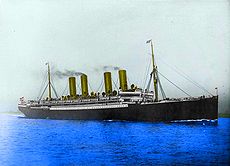 One of the four-stackers of the NDL, SS Kaiser Wilhelm der Grosse
One of the four-stackers of the NDL, SS Kaiser Wilhelm der Grosse
Expansion and dominance
H.H. Meyer stood down from the board in 1888; he was succeeded by Friedrich Reck. Johann Georg Lohmann became Director of the company; following his death in 1892, Reck stepped down and Georg Plate became chairman. The lawyer Heinrich Wiegand became Director; from 1899 onwards, his title was Director General. He held this position until 1909,[6] and presided over appreciable expansion.
In 1897, with the commissioning of SS Kaiser Wilhelm der Große, the NDL finally had a major ship for the North Atlantic. This was the largest and fastest ship in the world, and the company benefited from the reputation advantage of the Blue Riband for the fastest Atlantic crossing, with an average speed of 22.3 knots. Between 1897 and 1907, the line followed with three further four-screw and four-funnel steamers of the Kaiser class, of 14,000–19,000 GT: the SS Kronprinz Wilhelm, the SS Kaiser Wilhelm II and the SS Kronprinzessin Cecilie. With these the company offered a regular service across the Atlantic to its docks at Hoboken, New Jersey, across the Hudson River from New York.
So began the "decade of Germans" in transatlantic shipping, in which the NDL and the HAPAG dominated the routes with several record-breaking ships and vied with the British Cunard Line and the White Star Line as the largest shipping companies in the world. In 1902 and 1904, two NDL ships again won the Blue Riband: SS Kronprinz Wilhelm, now with an average speed of 23.09 knots, for the westbound passage from Cherbourg to New York and the Kaiser Wilhelm II with 23.58 knots in the eastbound passage. In 1907, RMS Lusitania, and then in 1909, RMS Mauretania, both of the British Cunard Line, won the Blue Riband back for the British, and Mauretania then retained it until 1929.[6]
Between 1894 and 1908, NDL ordered many other freight and passenger steamers from several German yards. These included the Barbarossa class (over 10,000 GRT, for Australia, the Far East, and the North Atlantic) and the Generals class (approximately 8,500 BRT, for the Far East and Australia).
NDL in the 20th century
 Kaiser Wilhelm II speaking at the departure of SS Friedrich Der Grosse with German troops to put down the Boxer rebellion in China
Kaiser Wilhelm II speaking at the departure of SS Friedrich Der Grosse with German troops to put down the Boxer rebellion in China
From 1899, the NDL acquired 25 British-owned coastal steamers, which were used in the Pacific. Passenger service to Asia was offered in conjunction with the HAPAG beginning in 1900.[10] In 1900, 14 of NDL's passenger ships were requisitioned as troop transports due to the Boxer Rebellion in China; on 27 July, Kaiser Wilhelm II delivered his "Schrecklichkeit" speech, in which he compared the military of the German Empire to the Huns, at the departure ceremony for Friedrich Der Grosse.[11][12]
At the beginning of the 20th century, the U.S. banking magnate J.P. Morgan began to acquire a number of shipping companies, including the White Star Line, the Leyland Line, and the Red Star Line, to build a transatlantic monopoly. He succeeded in signing both HAPAG and NDL to an alliance, but was unable to acquire the British Cunard Line, and the French Compagnie Générale Transatlantique (CGT).[13] HAPAG and NDL gave Morgan the largest U.S. rail company, the Baltimore and Ohio Railroad, and so Morgan offered to divide the market. The Holland-America Line and the Red Star Line together divided a contract for the passengers of the four companies. Ruinous competition was prevented. In 1912, the Morgan Agreement was terminated.[14]
In 1907, the Norddeutscher Lloyd's fiftieth anniversary, it had 93 vessels, 51 smaller vessels, two sail training vessels and other river steamers. NDL had around 15,000 employees. Because of the high investment costs and an international economic crisis, the shipping company celebrated at this time but also with considerable financial difficulties.[15]
Despite the financial difficulties, between 1907 and 1910 the company built a new headquarters on Papenburgstrasse in Bremen, the prestigious NDL Building to plans by architect Johann Poppe, who was also the lead interior designer for the company's liners. The building, the largest in the city at the time, was in eclectic Renaissance Revival style with a tower. It was sold in 1942 to Deutsche Schiff- und Maschinenbau and when the company was broken up into its constituent parts after World War II, passed to AG Weser. However, it had been severely damaged by bombing and was ultimately demolished and a Horten department store built on the site in 1969. The adjacent new shopping mall bears the name Lloyd Passage.[16]
The lucrative North Atlantic route was extremely competitive in this period, with new, attractive ships from other large companies including the RMS Lusitania and RMS Mauretania of the Cunard Line, and the RMS Olympic, RMS Titanic and RMS Britannic of the White Star Line. The HAPAG introduced three new vessels of the Imperator class, SS Imperator, SS Vaterland, and SS Bismarck, with a size of 50,000 GT. The NDL responded with smaller but prestigious vessels such as the SS Prinz Friedrich Wilhelm and the SS George Washington, and transferred the SS Berlin from Mediterranean service to the New York run. Finally in 1914 the company ordered two 33,000 GRT liners of the Columbus class; however, World War I prevented their completion.[17]
In 1914, NDL employed approximately 22,000 people. Its success thus directly influenced the rapid growth of the city of Bremerhaven, which had been founded only in 1827.
Director General Dr. Wiegand died in 1909, and was succeeded by Dr. Phillip Heineken until 1920.[18]
NDL's routes around 1907
This is a list of routes served by NDL in 1907.[19]
Europe - America
- Bremerhaven - New York
- Bremerhaven - Baltimore
- Bremerhaven - Savannah
- Bremerhaven - Galveston
- Bremerhaven - Cuba
- Bremerhaven - La Plata ports
- Bremerhaven - Brazil
- Genoa - New York
Mediterranean
- Marseilles - Alexandria
Europe - Asia/Australia
- Bremerhaven - East Asia
- Bremerhaven - Australia
Asia / Australia (including coastal routes)
- Hong Kong - Japan - New Guinea
- Hong Kong - Bangkok
- Hong Kong - Bangkok (via Singapore)
- Hong Kong Straits
- Hong Kong - South Philippines
- Penang - Deli
- Deli - Singapore
- Singapore - Bangkok
- Singapore - South Philippines
- Singapore - Moluccas (on Borneo)
- Singapore - Moluccas (on Celebes)
- Shanghai - Hankow
- Australia - Japan - Manila - Hong Kong
German coast
- Sea-bathing passenger service on the North Coast
- Tug service Bremen - Hamburg and Bremen - Bremerhaven
- Passenger shipping Bremen - Bremerhaven
World War I
For NDL as a civilian shpping line, the beginning of World War I was a trial, as well as a logistical challenge because a large part of the fleet was at sea around the world. However, most ships were able to reach neutral ports. The logistical operations of the NDL in Bremerhaven would now be almost exclusively in the service of the German Navy.[20] NDL owned a majority interest in the Deutsche Ozean-Rhederei (German Ocean Shipping Service), which used U-boats for trade and made some successful Atlantic crossings.
Post war
At the start of the war, the NDL's fleet totaled more than 900,000 GRT. Under the Treaty of Versailles at war's end, all ships over 1,600 GRT and half of all units from 100 to 1,600 GRT were confiscated.[21] The United States had already confiscated in 1917 the facilities in Hoboken and the NDL ships at the dock there. The prewar NDL fleet no longer existed.[20] The company was left with some small ships totalling 57,000 GRT. With these the company restarted sea-bathing passenger service, tug service, and freight service in 1919. The 'flagship' was the 781-ton Grüß Gott. From 1920 to 1939, NDL participated in the Seedienst Ostpreußen passenger and goods service to East Prussia.
In 1920, an air transport subsidiary was founded and soon merged with Sablatnig Flugzeugbau GmbH to form Lloyd Luftverkehr Sablatnig. In 1923 this combined with HAPAG's air transport subsidiary to form Deutscher Aero Lloyd, which on 6 January 1926 merged with Junkers Luftverkehr AG to become Deutsche Luft Hansa A.G., the predecessor of Lufthansa.
In August 1920, the NDL made an agency agreement with The U.S. Mail (beginning in 1921, United States Lines). This made it possible to resume transatlatic service from Bremerhaven to New York with the former Rhein, now sailing under the US flag as the Susquehanna. The unfinished Columbus had been awarded to Great Britain after the war and was bought in 1920 by White Star, which had lost significant tonnage in the war and also wished to make up for the pre-war loss of the Titanic. However, work at Danzig proceeded very slowly. Finally in autumn 1921 the so-called Columbus Agreement was reached, under which the German government and NDL undertook to facilitate rapid completion of the Columbus in exchange for the British government returning ownership to the NDL of six smaller ships which had spent the war years in South America: the postal steamers Seydlitz and Yorck, the Gotha, and the freighters Göttingen, Westfalen and Holstein. The other ship of the Columbus class, the 32,354 GRT former Hindenburg, was completed in 1924 and named Columbus; she was placed in scheduled transatlantic passenger service. The company also began to build new freighters and passenger ships and to buy back other ships.[22] In late 1921, service to South America was resumed with the Seydlitz, and in early 1922, East Asian service with the Westfalen.
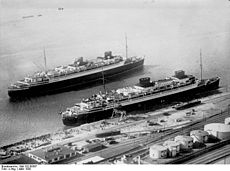 Flagships of North German Lloyd in 1930 - Bremen and Europa, the biggest German liners
Flagships of North German Lloyd in 1930 - Bremen and Europa, the biggest German liners
A brief post-war boom was followed by severe inflation in Germany, despite which NDL continued to expand their fleet. Twelve new ships of between 8,700 and 11,400 GRT were placed in service for South and Central America and the Far East, then in addition to Columbus three new ships of between 13,000 and 15,000 GRT for the North Atlantic (the München, Stuttgart and Berlin), and in 1927 the former Zeppelin was bought back from Great Britain and placed in service as the Dresden.[23]
In 1920, Carl Stimming became Director General of NDL, while his predecessor Heineken became Chairman of the Board. Between 1925 and 1928, the company acquired a number of German shipping companies: HABAL, the Roland Line, and Argo.[24] The acquisistion of the Roland Line brought Ernst Glässel onto the Board of Directors, where he was to have increasing influence. In 1926, the company were once more able to pay a dividend. American credit financed continuing expansion and orders for new ships.
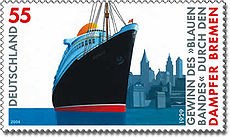 SS Bremen depicted on a German postage stamp
SS Bremen depicted on a German postage stamp
In 1929 and 1930, the company placed its two largest ships in service, SS Bremen (51,656 GRT) and SS Europa (49,746 GRT). With an average speed of about 27.9 knots, both were to take the Blue Riband for the fastest Atlantic crossings.[20] In 1929, Columbus was completely refitted.
From 1928 to 1939, the volume of passengers travelling between the USA and Europe declined sharply. In 1928, the NDL transported about 8% of a passenger volume of 1,168,414 passengers; in 1932, 16.2% of the 751,592 passengers transported; in 1938, around 11% of 685,655 passengers. In addition, there was significant new competition from new Italian, French and British superliners: the Italian SS Rex (51,062 GRT) and SS Conte di Savoia (48,502 GRT), the French SS Normandie (79,280 GRT), and the British RMS Queen Mary (80,744 GRT).[25]
The 1929 economic crisis which began in the US affected the German shipping companies. In 1930, the NDL and the HAPAG therefore entered into a cooperation agreement, and beginning in 1935, instituted joint operations in the North Atlantic. The first signs of a merger were visible. By 1932, the NDL was in an economic crisis, with about 5,000 employees let go, salary cuts, and red ink. Glässel was dismissed. The government placed both NDL and HAPAG in trusteeship under Siegfried Graf von Roedern, and Heinrich F. Albert very briefly became head of the NDL, quicly followed by the National Socialist Rudolph Firle.[26] Bremen State Councillor Karl Lindemann was Chairman of the Board from 1933 to 1945.[27] A programme of economic recovery of by divestments and restructuring was initiated. HBAL and the Roland Line became independent companies once more, and other lines took over services to Africa and the Mediterranean. The Nazi regime ordered both NDL and HAPAG to relinquish ships to other lines which were to operate in their regions without competition from other German companies, in particular to Hamburg Süd, the Deutsche Afrika-Linien and the Deutsche Levante Linie.
In 1935, the Scharnhorst, Gneisenau, and Potsdam, each with about 18,000 GRT, were placed in service for the Far East. The modernization of the fleet continued and in 1937 the line made modest profits. In 1939 NDL had in service 70 vessels with a total of 562,371 GRT, including the sail training vessel Kommodore Johnsen (now the Russian Sedov), 3 sea-bathing ships, 19 tugs and 125 small ships, and employed 12,255, 8,811 on vessels. Nine further freighters were completed after the outbreak of World War II. This entire fleet was either lost during the war or awarded to the Allies as reparations. Columbus had to be sunk in 1939; Bremen burned in 1941; Steuben was sunk in the Baltic in 1945 with the loss of some 4,000 lives; Europa, claimed by France, became the Liberté in 1947.[20]
The Reich was the primary stockholder in the company, but in 1941/42, NDL was once more privatized and cigarette manufacturer Philipp Reemtsma became primary stockholder.[28] Dr. John Kulenkampff, a Board member since 1932, and Richard Bertram, a Board member since 1937, became Chairmen in 1942.
After World War II
At the end of World War II the company's headquarters had been severely damaged by bombing and all its large vessels either destroyed or seized. It was left with only the freighter Bogotá, which was in Japan. Relicensed by the American military administration on November 29, 1945 as a "coastal shipping and stevedoring company," it started again, as after World War I, practically from zero, offering tugboat and bathing services. Kulenkampff and Bertram constituted the Board and there were at first only 350 employees. In 1948, the first Hapag-Lloyd travel agency opened. Business initially consisted of emigration and a limited amount of tourism. Beginning in 1949, German companies were permitted to order and to build ships of up to 7,200 GRT. In 1950, the NDL placed its first post-war orders at the Bremer Vulkan shipyard, the Rheinstein class (2,791 GRT, 13 knots).[29]
After the limitations on German shipping imposed by the Allies were lifted in 1951,[30] the NDL commenced building a new fleet. First it bought older freighters (for example the Nabob, a former American auxiliary aircraft carrier) and had new freighters built between 4,000 and 9,000 GRT and 5,000 and 13,000 DWT, all with names ending in -stein. The line had routes to Canada, New Orleans, the Canary Islands, and beginning in 1953 to the Far East.
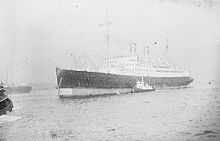 The MS Gripsholm, later the NDL's MS Berlin
The MS Gripsholm, later the NDL's MS Berlin
Passenger service resumed in 1955 using a rebuilt 1924 Swedish ship, the 17,993 GRT MS Gripsholm. Renamed Berlin, she was the sixth German ship of that name, the fourth at NDL, and sailed North Atlantic routes. In 1959, the company added the 32,336 GRT Bremen (formerly Pasteur), and in 1965, the 21,514 GRT Europa (formerly Kungsholm), Gripsholm's sister ship bought from the Swedish American Line, with a capacity of 843 passengers.[20] These vessels were first placed in scheduled service to America but soon transferred to cruising. In 1967, the 10,481 GRT express freighter Friesenstein (21.5 knots) inaugurated the Friesenstein class and replaced Nabob and Schwabenstein. Passenger service was running at an increasing deficit, and the rapidly growing container traffic required cost-intensive retooling in the freight business. In 1968 NDL inaugurated container service to the USA with the 13,384 GRT Weser-Express; two more container ships were soon added.
Around 1960, NDL had 47 ships, a number that remained almost unchanged until 1970. In 1968, the fleet totaled 343,355 GRT (in 1970, 391,313 GRT) and was the 16th largest shipping company worldwide; HAPAG, with 410,786 GRT, was the 9th largest.[31] In 1970, NDL had a turnover of 515 million DM and share capital of 54 million DM, and employed 6,200 people, 3,500 of them at sea.[32]
In 1967, Claus Wätjen and Dr. Horst Willner, and in 1969 Karl-Heinz Sager, joined the Board. Kulenkampff served on the Board until 1968 and Bertram until 1970. Since the NDL was already executing three quarters of its freight business in association with HAPAG, a merger of the two largest German shipping companies was entirely logical.[33]
On September 1, 1970, the North German Lloyd merged with Hamburg America Line (HAPAG) to form Hapag-Lloyd AG, based in Hamburg with secondary headquarters in Bremen.[20]
Legacy
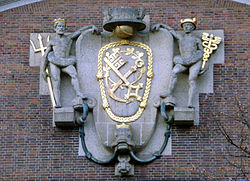 NDL's emblem on the wall of the former company headquarters at the Bremen main station
NDL's emblem on the wall of the former company headquarters at the Bremen main station
- The new company has Lloyd as part of its name.
- The Lloyd Werft in Bremerhaven, with its headquarters in the former laundry facility, continues the memory of the NDL.
- The former company headquarters on Papenstraße was demolished and replaced by a department store in 1969, but the Große Hundestraße on one side of the site was the first street in Bremen to be privatized, and has been roofed with glass to become a pedestrian mall. It is called Lloyd Passage.[16]
- The Lloyd baggage department building or Lloyd station on Gustav Deetjen Allee at the main station in Bremen, built in 1913 to Rudolph Jacobs' design, became Hapag-Lloyd's secondary headquarters. The NDL's company emblem adorns the main entrance.[34] Almost all company buildings are now in Hamburg and Hanover.[35]
- The Lloyd Dynamowerke (LDW) in Bremen[36]
- Buildings in Bremen and Bremerhaven still bear the marks of former use by the NDL.[37]
- The Bremer Bank, now absorbed by Commerzbank, was founded by Meier to provide financing.
Major people
- Hermann Henrich Meier, founder and 1857-1888 first Supervisory Board Chairman of the NDL[38]
- Eduard Crüsemann; 1857-1869 founder and first director of NDL[39]
- August Hermann Friedrich Neynaber alias HFA or HAF called Hermann Neynaber; (1822–1899) captain of many liners from 1866 to 1881 (Bremen, Deutschland, Donau, Mosel, Kronprinz Friedrich Wilhelm, Rhein)[40]
- Johann Georg Lohmann, 1877-1892 Director of NDL[21][41]
- Hermann Friedrich Bremermann; 1868-1892 Director of the NDL
- Willy Christoffers; Captain from 1886 to 1900
- Georg Plate, from 1887 to the Supervisory Board of the NDL, 1892-1911 Chairman of the NDL
- Dr. Heinrich Wiegand; 1892–1899 Director and 1899-1909 Director-General of NDL[42]
- Charles Polack, captain in 1913 of the SS Kronprinzessin Cecilie[43]
- Dr. Philipp Heineken, Director-General in 1909-1920, 1920-1933 Chairman of the Supervisory Board of NDL[44]
- Carl Joachim Stimming From 1920 Director/ General, Bureau of Lloyds to 1932[45]
- Arnold Petzet; from 1906 to 1927 in NDL's board and is responsible for binnländisches transport, establishment of the travel sector[46]
- Ernst Glässel; 1926 alternate Lloyd Executive Board, 1931-1932 Chairman of the Lloyds[47]
- Dietrich Hogemann, commodore who retired in 1913[48]
- Paul König, 1911 captain, 1916 captain of the U-boat, 1920-1932 Head of the marine department of the NDL[49]
- Nikolaus Johnsen, captain and commodore in 1924 of the Columbus, and in 1930 Europe (III)[50]
- Leopold Ziegenbein, captain and commodore of Bremen (IV)[51]
- Oskar Scharf, captain on the Europa (III)[52][53]
- Adolf Ahrens, captain and commodore of Columbus and Bremen (IV)[54]
- Dr. Heinrich F. Albert, 1932-1933 Director General of the NDL[55][56]
- Karl Lindemann (ex State Council), 1933-1945 Chairman of the Supervisory Board of NDL[57]
- Dr. Rudolph Firle, 1933-1944. Director General of the NDL[54]
- Dr. Johnannes Kulenkampff; From 1932 Board Member and Executive Board from 1942 onwards of the NDL[33]
- Richard Bertram; From 1937 Board Member and Executive Board from 1942 onwards of the NDL[33]
- Paul Hampel, director of ship maintenance of the NDL of about 1950 to 1970
- Heinrich Lorenz, captain of the Berlin (IV)[58]
- Günter Rössing, captain of the Bremen (V)[59]
Fleets
-
This list is incomplete; you can help by expanding it.
This is a list of all ships in service of the NDL. Some of the ships were owned previously by other companies.[8]
Year Name Tonnage Shipyard Fate/Status 1858 Bremen (I) 2,674 GRT Caird & Co. Ltd., Greenock 1874 sold to E.Bates, Liverpool converted to sail. 1858 New York 2,674 GRT Caird & Co. Ltd., Greenock 1874 sold to E.Bates, Liverpool, converted to sail; wrecked off Staten Island and sank in 1891 1858 Hudson 2,266 GRT Palmer Bros. & Co. Ltd., Yarrow 1858 burned out at Bremen, rebuilt and in 1863 became Louisiana for National Line 1858 Weser (I) 2,266 GRT Palmer Bros. & Co. Ltd., Yarrow 1859 sold to French Navy 1861 Hansa (I) 2,992 GRT Caird & Co. Ltd., Greenock 1879 1879 sold to shipbuilders in part exchange for Hansa (II) 1863 America (I) 2,752 GRT Caird & Co. Ltd., Greenock 1894 sold to Italy, renamed Orazio 1865 Hermann 2,713 GRT Caird & Co. Ltd., Greenock 1893 sold to shipbuilder in part exchange for H.H. Meier 1866 Deutschland 2,947 GRT Caird & Co. Ltd. 1875 wrecked in Thames Estuary; loss of 57 lives 1867 Union 2,880 GRT Caird & Co. Ltd., Greenock 1870 wrecked on Rattray Head, Aberdeen; no loss of life 1867 Weser (II) 2,823 GRT Caird & Co. Ltd., Greenock 1896 scrapped 1868 Rhein (I) 2,901 GRT Caird & Co. Ltd., Greenock 1891 sold to Gray, Liverpool 1868 Main (I) 2,899 GRT Caird & Co. Ltd., Greenock 1891 sold to Anglo-American SS Co. 1869 Donau (I) 2,896 GRT Caird & Co. Ltd., Greenock 1889 sold to H. Bischoff, Bremen 1868 Baltimore 2,316 GRT Caird & Co. Ltd., Greenock 1894 scrapped 1868 Berlin (I) 2,334 GRT Caird & Co. Ltd., Greenock 1894 sold to Italy, renamed M. Bruzzo 1869 Ohio 2,393 GRT Caird & Co. Ltd., Greenock 1894 sold to shipbuilder in part exchange for new ships, resold to Italy renamed Amazzone. 1869 Leipzig (I) 2,384 GRT Caird & Co. Ltd., Greenock 1894 sold to Hamburg owners. 1869 Frankfurt (I) 2,582 GRT Caird & Co. Ltd., Greenock 1894 sold to shipbuilder in part exchange for new ships. 1869 Hanover (I) 2,571 GRT Caird & Co. Ltd., Greenock 1894 scrapped 1870 Cologne (I) 2,556 GRT Caird & Co. Ltd., Greenock 1895 sold to be scrapped 1870 Koln (I) 2,555 GRT Caird & Co. Ltd., Greenock 1895 sold to be scrapped 1871 König Wilhelm I 2,400 GRT Caird & Co. Ltd., Greenock 1873 stranded at Holland; no life lost. 1871 Kronprinz Friedrich Wilhelm 2,387 GRT Caird & Co. Ltd., Greenock 1897 scrapped 1871 Graf Bismarck 2,393 GRT Caird & Co. Ltd., Greenock 1898 scrapped 1872 Strasburg (I) 3,025 GRT Caird & Co. Ltd., Greenock 1896 sold to be scrapped 1872 Mosel (I) 3,114 GRT Caird & Co. Ltd., Greenock 1882 wrecked Cornwall; no life lost. 1873 Braunschweig 3,079 GRT R. Steele & Co. Ltd., Greenock 1896 scrapped 1873 Feldmarschall Moltke 3,060 GRT Caird & Co. Ltd., Greenock 1875 sold to P&O and renamed Assam 1873 Minister Roon 3,066 GRT Caird & Co. Ltd., Greenock 1875 sold to P&O and renamed Siam 1873 Hohenzollern (I) 3,092 GRT Caird & Co. Ltd., Greenock 1899 sold to Hong Kong. 1874 Nürnberg (I) 3,116 GRT R. Steele & Co. Ltd., Greenock 1895 sold to F.Raben, Vegesack, scrapped. 1874 Hohenstaufen 3,090 GRT Earle's Shipbuilding & Eng. Co. Ltd., Hull 1897 sold to be scrapped 1874 Oder (I) 3,158 GRT Caird & Co. Ltd., Greenock 1887 wrecked at Socotra Islands 1874 Neckar (I) 3,120 GRT Caird & Co. Ltd., Greenock 1896 sold to be scrapped 1874 General Werder 3,020 GRT Caird & Co. Ltd., Greenock 1892 given for new building in payment 1875 Salier 3,083 GRT Earle's Shipbuilding & Eng. Co. Ltd., Hull 1896 wrecked on Spanish coast; loss of 279 lives. 1876 Habsburg 3,094 GRT Earle's Shipbuilding & Eng. Co. Ltd., Hull 1898 sold to be scrapped 1881 Elbe (I) 4,510 GRT John Elder & Co. Ltd., Glasgow 1895 Sunk after collision in the English Channel (332 Death) 1882 Werra (I) 4,815 GRT John Elder & Co. Ltd., Glasgow 1901 sold to be scrapped 1883 Fulda (I) 4,814 GRT John Elder & Co. Ltd., Glasgow 1899 rebuilding abort after heavy damage and scrap 1884 Eider (I) 5,129 GRT John Elder & Co. Ltd., Glasgow 1892 stranded at Isle of Wight, refloated and scrapped. 1884 Ems (I) 5,129 GRT John Elder & Co. Ltd., Glasgow Sold to Elder Dempster Lines, renamed Lake Simcoe. 1886 Aller (I) 4,964 GRT Fairfield Shipbuilding & Eng. Co. Ltd., Glasgow 1904 scrapped 1886 Trave (I) 4,996 GRT Fairfield Shipbuilding & Eng. Co. Ltd., Glasgow 1908 sold to be scrapped 1886 Saale (I) 4,967 GRT Fairfield Shipbuilding & Eng. Co. Ltd., Glasgow 1901 sold 1887 Lahn (I) 5,097 GRT Fairfield Shipbuilding & Eng. Co. Ltd., Glasgow 1904 sold 1890 Spree (I) 6,963 GRT AG Vulcan, Stettin 1899: Rebuilt and renamed to 7,840 GRT Kaiserin Maria Theresia. 1904 sold to Russian Navy, renamed Ural. 1891 Havel (I) 6,963 GRT AG Vulcan, Stettin 1898 scrapped 1886 Preussen 4,577 GRT AG Vulcan, Stettin 1909 sold to be scrapped 1887 Bayern 4,574 GRT AG Vulcan, Stettin 1909 sold to be scrapped 1887 Sachsen 4,571 GRT AG Vulcan, Stettin 1909 sold to be scrapped 1889 Kaiser Wilhelm II (I) 6,990 GRT AG Vulcan, Stettin 1900: Rebuilt to 6,668 GRT, 1901: Renamed Hohenzollern (II), 1908: stranded at Sardinia, refloated and scrapped. 1888 Dresden (I) 4,802 GRT Fairfield Shipbuilding & Eng. Co. Ltd., Glasgow 1903 renamed Helius, 1906 sold to Turkish Government and renamed BEZMI-I ALEM, 1914 sunk Black Sea 1889 München (I) 4,803 GRT Fairfield Shipbuilding & Eng. Co. Ltd., Glasgow 1902 scrapped 1889 Karlsruhe (I) 5,347 GRT Fairfield Shipbuilding & Eng. Co. Ltd., Glasgow 1908 sold to be scrapped 1889 Stuttgart (I) 5,349 GRT Fairfield Shipbuilding & Eng. Co. Ltd., Glasgow 1908 sold to be scrapped 1890 Darmstadt 5,316 GRT Fairfield Shipbuilding & Eng. Co. Ltd., Glasgow 1911 scrapped 1890 Gera (I) 5,319 GRT Fairfield Shipbuilding & Eng. Co. Ltd., Glasgow 1909 scrapped 1891 Oldenburg 5,317 GRT Fairfield Shipbuilding & Eng. Co. Ltd., Glasgow 1911 scrapped 1891 Weimar 5,316 GRT Fairfield Shipbuilding & Eng. Co. Ltd., Glasgow 1908 scrapped 1892 H. H. Meier 5,481 GRT Armstrong, Mitchell & Co. Ltd., Newcastle 1901 scrapped 1893 Pfalz (I) 3,874 GRT Wigham Richardson & Co. Ltd., Newcastle 1904 sunk 1893 Mark (I) 3,936 GRT Armstrong, Mitchell & Co. Ltd., Newcastle 1915 Sunk by Royal Navy off Tanga, Tanzania 1894 Prinzregent Luitpold 6,288 GRT F. Schichau, Danzig 1914 laid up in Messina / 1915 seized by Italy, renamed Pietro Calvi 1894 Prinz Heinrich 6,263 GRT F. Schichau, Danzig 1914 laid up in Lisbon / 1916 seized by Portugal, renamed Porto 1894 Wittekind 5,001 GRT Blohm & Voss AG, Hamburg 1914 laid up in Boston / 1917 seized by United States Shipping Board, renamed Iroquois 1894 Willehad 5,003 GRT Blohm & Voss AG, Hamburg 1914 laid up in Boston / 1917 seized by US Shipping Board, renamed Wyandotte 1896 Friedrich der Große 10,531 GRT AG Vulcan, Stettin 1914 laid up in New York / 1917 seized by US Shipping Board, renamed Huron 1897 Coblenz (I) 3,169 GRT Blohm & Voss AG, Hamburg Interned in Manila, August 1914 seized by U.S., 6 April 1917
1897 Barbarossa 10,769 GRT Blohm & Voss AG, Hamburg 1914 laid up in New York / 1917 seized by US Shipping Board, renamed Mercury 1897 Königin Luise 10,566 GRT AG Vulcan, Stettin 1919 ceded to Britain as war reparation, 1921 to Orient Line, renamed Omar. 1897 Bremen (II) 10,522 GRT F. Schichau, Danzig 1919 ceded to Britain as war reparation, 1921 to Byron Line, renamed Constantinople. 1899 König Albert 10,643 GRT AG Vulcan, Stettin 1915 seized by Italy and was renamed Ferdinando Palasciano. 1900 Großer Kurfürst 13,183 GRT F. Schichau, Danzig 1914 1917 seized by USA renamed Aeolus. 1900 Prinzessin Irene 10,881 GRT AG Vulcan, Stettin 1917 seized by USA renamed Pocahontas, 1922 re-purchased by NDL renamed Bremen (III), 1928 renamed Karlsruhe (II), 1932 scrapped. 1900 Princess Alice 10,911 GRT AG Vulcan, Stettin ex-Kiautschou, 1904 purchased from Hamburg America Line and renamed Princess Alice, 1917 seized by USA, renamed Princess Matoika. 1897 Kaiser Wilhelm der Grosse 14,349 GRT AG Vulcan, Stettin 1914 became German armed merchant cruiser, 1914 sunk by HMS Highflyer at Rio de Oro, Spanish Sahara. 1901 Kronprinz Wilhelm 14,908 GRT AG Vulcan, Stettin 1914 became German commerce raider, 1915 interned in Newport News, Virginia, 1917 seized by USA, renamed Von Steuben. 1898 Kaiser Friedrich 12,481 GRT F. Schichau, Danzig Could not reach specified speed, 1899 chartered to HAPAG, 1900-1912 laid up, 1912 sold to Compagnie de Navigation Sud-Atlantique, Paris, renamed Burdigala. 1899 Rhein (II) 10,058 GRT Blohm & Voss AG, Hamburg 1917 seized by USA, renamed Susquehanna 1900 Main (II) 10,067 GRT Blohm & Voss AG, Hamburg 1919 ceded to Britain as war reparation 1901 Neckar (II) 9,835 GRT J. C. Tecklenborg AG, Geestemünde 1917 seized by USA, renamed Antigone 1899 Köln (II) 7,409 GRT J. C. Tecklenborg AG, Geestemünde 1917 seized by USA, renamed Amphion 1899 Hanover (II) 7,305 GRT Wigham Richardson & Co. Ltd., Newcastle 1919 ceded to Britain as war reparation, 1921 repurchased by NDL, rebuilt to 7438 tons, 1933 scrapped. 1900 Frankfurt (II) 7,431 GRT J. C. Tecklenborg AG, Geestemünde 1919 ceded to Britain as war reparation, 1922 renamed Sarvistan. 1901 Cassel 7,543 GRT J. C. Tecklenborg AG, Geestemünde 1919 ceded to France as war reparation, renamed Marechal Gallieni 1901 Breslau 7,524 GRT Bremer Vulkan AG, Vegesack 1917 seized by USA, renamed Bridgeport 1902 Chemnitz (I) 7,542 GRT J. C. Tecklenborg AG, Geestemünde 1919 ceded to Britain as war reparation 1902 Brandenburg 7,532 GRT Bremer Vulkan AG, Vegesack 1919 ceded by Britain as war reparation, 1922 renamed Hecuba and transferred to Alfred Holt & Co. (Blue Funnel Line) 1900 Strassburg (II) 5,057 GRT Bremer Vulkan AG, Vegesack 1904 transferred to Hamburg America Line, renamed Slavonia. 1900 Würzburg 5,085 GRT Bremer Vulkan AG, Vegesack 1916 seized by Portugal, renamed Sao Vicente 1902 Schleswig 6,955 GRT AG Vulcan, Stettin 1919 to France as war reparation, 1921 renamed General Duchesne, management was transferred to Messageries Maritimes 1902 Erlangen (I) 5,285 GRT Bremer Vulkan AG, Vegesack 1917 mined and sunk in North Sea; loss of 19 lives 1903 Kaiser Wilhelm II (II) 19,361 GRT AG Vulcan, Stettin 1914 laid up in New York / 1917 seized by USA, renamed Agamemnon 1907 Kronprinzessin Cecilie 19,360 GRT AG Vulcan, Stettin 1914 laid up in Boston / 1917 seized by USA, renamed Mount Vernon 1903 Zieten 8,066 GRT F. Schichau, Danzig 1916 seized by Portugal, renamed Tungue 1903 Roon 8,022 GRT J. C. Tecklenborg AG, Geestemünde 1919 ceded to Britain, 1921 to Greece, renamed Constantinoupolis 1903 Seydlitz 7,942 GRT F. Schichau, Stettin 1933 scrapped 1903 Gneisenau (I) 8,081 GRT AG Vulcan, Stettin 1918 seized by Belgium, 1919 sold to Italy, 1921 renamed Citta di Genova 1904 Scharnhorst (I) 8,131 GRT J. C. Tecklenborg AG, Geestemünde 1919 seized by France, 1920 transferred to French Line, renamed La Bourdonnais 1906 Yorck 8,901 GRT F. Schichau, Danzig 1933 scrapped 1906 Bülow 9,028 GRT J. C. Tecklenborg AG, Geestemünde 1914 laid up in Lisbon / 1916 seized by Portugal, renamed Tras-os-Montes 1907 Kleist 8,950 GRT F. Schichau, Danzig 1919 ceded to Britain as war reparation, 1921 to Japan, renamed Yoshino Maru 1907 Goeben 8,792 GRT AG Weser, Bremen 1919 to France as war reparation, 1920 transferred to French Line and renamed Roussillon 1908 Derfflinger 9,060 GRT F. Schichau, Danzig 1914 seized by Britain, renamed Huntsgreen, 1923 repurchased by NDL, reverted to Derfflinger, 1932 scrapped 1908 Lützow 8,818 GRT AG Weser, Bremen 1914 seized by Britain, renamed Huntsend, 1923 repurchased by NDL, reverted to Lutzow, 1933 scrapped 1904 Prinz Eitel Friedrich 8,865 GRT AG Vulcan, Stettin 1914 became German commerce raider, 1915 interned in USA, 1917 seized by USA, renamed DeKalb 1906 Prinz Ludwig 9,630 GRT AG Vulcan, Stettin 1919 ceded to Britain as war reparation, 1920 transferred to Orient Line, renamed Orcades 1907 Prinz Friedrich Wilhelm 17,082 GRT J. C. Tecklenborg AG, Geestemünde 1920 ceded to Britain as war reparation, 1921 transferred to Canadian Pacific Steamship Co., renamed Empress of China then Empress of India 1907 Gotha 6,653 GRT Bremer Vulkan AG, Vegesack 1933 scrapped 1908 Giessen 6,583 GRT Bremer Vulkan AG, Vegesack 1919 ceded to Britain as war reparation, 1921 transferred to Ellerman Lines, renamed City of Harvard 1910 Coburg (I) 6,750 GRT Bremer Vulkan AG, Vegesack 1917 seized by Brazil, renamed Pocone 1910 Eisenach (I) 6,757 GRT Bremer Vulkan AG, Vegesack 1917 seized by Brazil, renamed Santarém 1909 George Washington 25,570 GRT AG Vulcan, Stettin 1917 seized by USA 1909 Berlin (II) 17,324 GRT AG Weser, Bremen 1919 ceded to Britain as war reparation, 1920 transferred to White Star Line, renamed Arabic 1912 Sierra Nevada (I) 8,235 GRT AG Vulcan, Stettin 1917 seized by Brazil, renamed Bage 1912 Sierra Ventana (I) 8,262 GRT Bremer Vulkan AG, Vegesack 1919 seized by France, management transferred to Cie. de Navigation Sud-Atlantique, renamed Alba. 1913 Sierra Córdoba (I) 8,226 GRT AG Vulcan, Stettin 1917 seized by Peru, renamed Callao 1913 Sierra Salvada 8,227 GRT Bremer Vulkan AG, Vegesack 1917 seized by Brazil, renamed Avare 1913 Pfalz (II) 6,557 GRT Bremer Vulkan AG, Vegesack 1914 captured by Britain, renamed Boorara. 1914 Columbus (I) 33,526 GRT F. Schichau, Danzig 1919 ceded to Britain as war reparation, 1920 transferred to White Star Line, renamed Homeric 1915 Zeppelin 14,167 GRT Bremer Vulkan AG, Vegesack 1920 ceded to Britain as war reparation, transferred to Orient Line, renamed Ormuz, 1927 repurchased by NDL, renamed Dresden (II), 1934 wrecked on Norwegian coast; loss of 4 lives 1922 Köln (III) 9,265 GRT Bremer Vulkan AG, Vegesack 1934 became cargo ship, 1940 wrecked on Swedish coast 1922 Crefeld (II) 9,573 GRT Flensburger Schiffbau-Gesellschaft 1934 became cargo ship, 1941 scuttled as blockship at Massawa 1922 Sierra Nevada (II) 8,736 GRT AG Vulcan, Stettin 1925 renamed Madrid, 1935 sold to Hamburg South America Line 1923 Sierra Ventana (II) 11,392 GRT Bremer Vulkan AG, Vegesack 1935 sold to Italian Line, renamed Sardegna 1924 Sierra Córdoba (II) 11,469 GRT Bremer Vulkan AG, Vegesack 1935 sold to Nazi Deutsche Arbeitsfront for Strength Through Joy cruising. 1945 captured by Britain, 1948 sank under tow 1924 Sierra Morena 11,430 GRT Bremer Vulkan AG, Vegesack 1935 sold to Nazi Deutsche Arbeitsfront for Strength Through Joy cruising, renamed Der Deutsche. 1946 became Russian-owned Asia 1922 Weser (III) 9,450 GRT AG Weser, Bremen 1931 laid up, 1933 scrapped 1923 Werra (II) 9,475 GRT AG Weser, Bremen 1935 sold to Italian Line, Genoa, renamed Calabria 1924 Saarbrücken 9,429 GRT AG Weser, Bremen 1935 sold to Italian Line, renamed Toscana 1924 Coblenz (II) 9,449 GRT AG Weser, Bremen 1935 sold to Italian Line, renamed Sicilia 1924 Trier (II) 9,415 GRT AG Weser, Bremen 1936 wrecked off Spain, salvaged and sold to Turkey as submarine depot ship Erkin 1924 Fulda (II) 9,492 GRT AG Weser, Bremen 1940 sold to Japan, renamed Teikoko Maru 1923 München (II) 13,325 GRT AG Vulkan, Stettin 1931 renamed General Von Steuben, 1938 renamed Steuben, 1945 torpedoed and sunk by Russian submarine in Baltic Sea; loss of over 2,700 lives. 1924 Stuttgart (II) 13,367 GRT AG Vulkan, Stettin 1938 sold to Nazi Deutsche Arbeitsfront for Strength Through Joy cruising. 1943 bombed and sunk at Gdynia 1924 Columbus (II) 32,354 GRT F. Schichau, Danzig 1939 scuttled in Atlantic Ocean to avoid capture by Royal Navy during World War II 1925 Berlin (III) 15,286 GRT Bremer Vulkan AG, Vegesack 1945 mined and sunk off Swinemunde, 1948 refloated, repaired, and renamed Admiral Nakhimov for USSR. 1986 sank in Black Sea after collision. 1927 Arucas 3,359 GRT Flensburger Schiffbau-Gesellschaft 1940 scuttled in North Atlantic to avoid capture by Royal Navy during World War II 1929 Bremen (IV) 51,656 GRT AG Weser, Bremen 1940 accommodation ship at Bremerhaven, 1941 burnt out in Bremerhaven, 1946 scrapped 1930 Europa (II) 49,746 GRT Blohm & Voss AG, Hamburg 1945 taken over by US Navy, renamed USS Europa, 1950 became French Line's SS Liberté 1935 Scharnhorst (II) 18,184 GRT AG Weser, Bremen 1942 sold to Japan and converted to aircraft carrier Shinyo. 1935 Gneisenau (II) 18,160 GRT AG Weser, Bremen 1943 mined and put ashore on Lolland Island, later scrapped 1935 Potsdam 17,528 GRT Blohm & Voss AG, Hamburg 1945 ceded for war reparations to Britain, 1946 became troopship Empire Fowey 1955 Berlin (IV) 18,600 GRT Armstrong, Whitworth & Co., Newcastle ex-Gripsholm, acquired from Swedish American Line by Bremen Amerika Line, jointly operated by Swedish America and NDL. 1955 renamed Berlin (IV), 1959 fully owned by NDL, 1966 scrapped. 1959 Bremen (V) 32,336 GRT Chantiers et Ateliers de St. Nazaire ex-Pasteur, purchased from Cie. de Navigation Sud-Atlantique in 1959, renamed Bremen, 1970 owned by Hapag-Lloyd after the merger of NDL and HAPAG, 1972 sold to Chandris Lines, Piraeus, renamed Regina Magna, 1977 sold to Philippine Singapore Ports Corporation and renamed Saudiphil I as a floating hotel in Jeddah, Saudi Arabia, 1980 sold as Filipinas Saudi I to Philsimport International in Hong Kong, 1980 sunk in Indian Ocean while towing to Taiwanese ship breaker. 1965 Europa (IV) 21,514 GRT De Schelde N.V., Vlissingen ex-Kungsholm, purchased from Swedish America Line in 1965, renamed Europa, 1970 owned by Hapag-Lloyd after the merger of NDL and HAPAG, 1981 sold to Panama, renamed Columbus C. References
- ^ NDL's history and house flag
- ^ Drechsel, Edwin (1994). Norddeutscher Lloyd, Bremen, 1857-1970: History, Fleet, Ship Mails. I. Vancouver, British Columbia: Cordillera Pub. Co.. ISBN 9781895590142. OCLC 30357825.
- ^ Rolf Böttcher: Ankunft des Raddampfers „Washington“ in Bremerhaven 1847. Bremerhaven 1997
- ^ Lloyd's Register
- ^ "Herr H.H. Meier Dead.; North German Lloyd Steamship Co.'s Founder Passes Away at Bremen." (pdf). The New York Times: p. 1. 19 November 1898. http://query.nytimes.com/gst/abstract.html?res=9905E2D71438E433A2575AC1A9679D94699ED7CF. Retrieved 2010-01-23.
- ^ a b c d Norway-Heritage
- ^ "GERMAN STEAMER ON FIRE.; The H.H. Meier Forced to Put Back by the Flames." (pdf). The New York Times: p. 1. 9 March 1897. http://query.nytimes.com/gst/abstract.html?res=9903E6D7153CE433A2575AC0A9659C94669ED7CF. Retrieved 2010-01-23.
- ^ a b The Ships List
- ^ Nord-deutscher Lloyd
- ^ Drechsel, Edwin (1994). Norddeutscher Lloyd, Bremen, 1857–1970: History, Fleet, Ship Mails, Volume 1. Vancouver, British Columbia: Cordillera Pub. Co. ISBN 9781895590081. OCLC 30357825.
- ^ "HISTORIC SHIPS TO PLY AGAIN". Los Angeles Times: p. II8. 1922-08-21.
- ^ Robert K. Massie. Dreadnought. London: Jonathan Cape. ISBN 0-224-03260-7.
- ^ Lamar Cecil, Albert Ballin: Business and Politics in Imperial Germany, 1888–1918, Princeton, New Jersey: Princeton University, 1967, OCLC 900428, pp. 52–53, 56–57.
- ^ Krass, Peter (May 2001). "He Did It!(creation of U.S. Steel by J.P. Morgan)". Across the Board (Professional Collection).
- ^ Atlantic reporter, Volume 81. Harvard University: West Publishing Company. 1912. p. 764.
- ^ a b Lloyd Passage, Bremen
- ^ "Great liner is launched" (pdf). New York Times: p. 4. 11 November 1908. http://query.nytimes.com/mem/archive-free/pdf?res=9801E2DB1739E333A25752C1A9679D946997D6CF. Retrieved 2008-08-01.
- ^ "Sees Big Sea Trade Aim.; National Demand Here for Great Merchant Fleet, Says Heineken." (pdf). The New York Times: p. 1. 26 July 1918. http://query.nytimes.com/gst/abstract.html?res=9401E1D6103BEE3ABC4E51DFB1668383609EDE. Retrieved 2010-01-22.
- ^ History of the North German Lloyd Steamship Company of Bremen (1898)
- ^ a b c d e f Kenneth T. Jackson (1995). The Encyclopedia of New York City. The New York Historical Society; Yale University Press. p. 854.
- ^ a b Hapag-Lloyd: The Ballin Era
- ^ The Classic Liners of Long Ago: Columbus
- ^ USS Zeppelin
- ^ The Ships List: Roland Line
- ^ Gibbs, Charles Robert Vernon (1957). Passenger Liners of the Western Ocean: A Record of Atlantic Steam and Motor Passenger Vessels from 1838 to the Present Day. John De Graff.
- ^ Hartmut Rübner: Konzentration und Krise der deutschen Schiffahrt. Maritime Wirtschaft und Politik im Kaiserreich, in der Weimarer Republik und im Nationalsozialismus. Bremen 2005, ISBN 3-89757-238-9
- ^ Reinhold Thiel, Die Geschichte des Norddeutschen Lloyd 1857–1970, volume 4 1920–1945 Bremen: Hauschild, 2006, ISBN 9783897572300, p. 123 (German)
- ^ Erik, Lindner: Die Reemtsmas. Geschichte einer deutschen Unternehmerfamilie, Hoffmann und Campe, Hamburg 2007, ISBN 3455095631
- ^ Behling, Helmut; Reinhold Thiel (1997) (in German). Bremer Vulkan: Ende einer Ära. Bremen: Hauschild. ISBN 9783931785680. OCLC 40363156.
- ^ "Year by Year 1951" – History Channel International
- ^ "List of Ship owners," Fischer Weltalmanach 1971.
- ^ Gardiner, Robert (1994). The golden age of shipping: the classic merchant ship, 1900-1960. University of Michigan: Conway Maritime Press. pp. 20. ISBN 0851775675.
- ^ a b c Hapag-Lloyd: Rebuilding and Merger
- ^ Gerhard Greß: Verkehrsknoten Bremen. EK-Verlag, Freiburg (2006) ISBN 3-88255-252-2
- ^ "Contact TUI Group." TUI AG. Retrieved on 29 May 2009.
- ^ Werkschronik zu Borgward
- ^ Hans Hermann Meyer: Die Bremer Altstadt – Wanderungen in die Vergangenheit. Veröffentlichung des Bremer Landesmuseums für Kunst und Kulturgeschichte Focke-Museum (Nr. 107), Edition Temmen, Bremen 2003, ISBN 3-86108-686-7
- ^ Wilhelm von Bippen: Meier, Hermann Henrich. In: Allgemeine Deutsche Biographie (ADB). Volume 52, Duncker & Humblot, Leipzig (1906), P. 291–294.
- ^ Hapag-Lloyd: The Early Years
- ^ Nautical magazine and journal of the naval reserve, Volume 53. New York Public Library: Brown, Son and Ferguson. 1884. p. 58. http://books.google.com/books?id=wggAAAAAMAAJ&pg=PA58&lpg=PA58&dq=Hermann+Neynaber&source=bl&ots=iNtpvnRFd1&sig=zwOHrUGfRSirFvYtiRuWvf2FDRU&hl=en&ei=8-RtS5GjKJPysQOuv9CyDQ&sa=X&oi=book_result&ct=result&resnum=2&ved=0CAoQ6AEwAQ#v=onepage&q=Hermann%20Neynaber&f=false. Retrieved 2010-02-06.
- ^ Paul Neubaur: Der Norddeutsche Lloyd. 50 Jahre der Entwicklung 1857–1907. Band I, Fr. Wilh. Grunow, Leipzig 1907. Page 44
- ^ "HEINRICH WIEGAND DEAD.; General Director of North German Lloyd Dies in Homburg Sanitarium." (pdf). The New York Times: p. 1. 30 March 1909. http://query.nytimes.com/gst/abstract.html?res=9B02E1DC1131E733A25753C3A9659C946897D6CF. Retrieved 2010-02-02.
- ^ "DINNER TO HONOR NOTED SEA CAPTAIN; Friends of Capt. Polack to Welcome Him When He Completes 100 Round Trips to Europe. MANY MEDALS FOR BRAVERY German Emperor, Queen Victoria, and King of Spain Have Decorated North German Lloyd Skipper." (pdf). The New York Times: p. 1. 15 March 1909. http://query.nytimes.com/gst/abstract.html?res=9500E7DC163AE633A25756C1A9659C946596D6CF. Retrieved 2010-02-02.
- ^ "SAYS ENGLAND CAN'T STARVE GERMANY; Philipp Heineken, North German Lloyd Director, Asserts Britain's Plan Is Impossible. STATE BEING REMODELED Success Already Attained in Self-Maintenance, He Says, Proves Her Ability to Win." (pdf). The New York Times: p. 1. 16 February 1915. http://query.nytimes.com/gst/abstract.html?res=9806E2D61538E633A25755C1A9649C946496D6CF. Retrieved 2010-02-04.
- ^ Carl Joachim Stimming Baruthiae-Erlangen. Deutsche Corps-Zeitung 48 (1931-1932). Pages 291-293
- ^ Schwarzwälder, Herbert: Das Große Bremen-Lexikon. Edition Temmen, Bremen 2003, ISBN 3-86108-693-X.
- ^ Karl Heinz Schwebel: "Haus Seefahrt" Bremen: seine Kaufleute und Kapitäne. Krohn, Bremen 1947, P. 76.
- ^ "Capt. Hogemann Makes His Last Voyage After 44 Years Spent at Sea." (PDF). New York Times. May 7, 1913. http://query.nytimes.com/mem/archive-free/pdf?res=9F02EFD8173FE633A25754C0A9639C946296D6CF. Retrieved 2009-08-06. "After the North German Lloyd liner Kronprinzessin Cecilie, arriving from Bremen yesterday, had been made fast to her pier in Hoboken Capt. Dietrich Hogemann, Commodore of the fleet, announced that it was his last voyage, and that Capt. Charles Polack of the George Washington would succeed him."
- ^ Hartmut Schwerdfeger & Erik Herlyn: Die Handels-U-Boote Deutschland und Bremen. Kurze-Schönholtz & Ziesener Verlag, Bremen 1997, ISBN 3-931148-99-8
- ^ Picture from Commons (used on German Wikipedia in the article ''Columbus (1924)'' and ''Europa (1928)'')
- ^ Deutsche Post AG: Geschichten um das Blaue Band: Rekorde, Legenden, Katastrophen
- ^ Luxury Liner Row: Norddeutscher Lloyd
- ^ Koch, Eric (1985). Deemed Suspect: A Wartime Blunder. Formac Publishing Company. p. 58. ISBN 0887801382. http://books.google.com/books?id=MCGblmhyKPYC&pg=PA58&lpg=PA58&dq=Oskar+Scharf&source=bl&ots=ioqjDenWAW&sig=dHlFcSNVRFohTY24ggfhQkIS-w4&hl=en&ei=4UJuS-z3OYPsswPc5ZiZCw&sa=X&oi=book_result&ct=result&resnum=4&ved=0CBEQ6AEwAw#v=onepage&q=Oskar%20Scharf&f=false. Retrieved 2010-02-06.
- ^ a b Herbert Schwarzwälder: Das Große Bremen-Lexikon. Edition Temmen, 2003, ISBN 3-86108-693-X
- ^ Picture from Commons (the description itself tells about NDL)
- ^ Wala, Michael; Reinhard R. Doerries (1999). Gesellschaft und Diplomatie im transatlantischen Kontext: Festschrift für Reinhard R. Doerries zum 65. Geburtstag. Franz Steiner Verlag. p. 151. ISBN 3515075291. http://books.google.com/books?id=foUJ_WotOYwC&pg=PA151&lpg=PA151&dq=Heinrich+Albert+lloyd&source=bl&ots=ZYvqsfr8bk&sig=aGuthAql-Grrkg7P23flo60EMI4&hl=en&ei=E0duS_LqKpG0sgPz8M2yDQ&sa=X&oi=book_result&ct=result&resnum=6&ved=0CBYQ6AEwBTgK#v=onepage&q=Heinrich%20Albert%20lloyd&f=false. Retrieved 2010-02-06.
- ^ Reinhold, Thiel: Die Geschichte des Norddeutschen Lloyd 1857–1970, Volume 5, 1945–1970. Bremen, 2006. P. 123
- ^ Harald Focke: Im Liniendienst auf dem Atlantik. Neue Erinnerungen an die Passagierschiffe BERLIN, BREMEN und EUROPA des Norddeutschen Lloyd. Hauschild Verlag, Bremen, 2006. ISBN 978-389757-339-0
- ^ Focke, Harald: Bremens letzte Liner. Die großen Passagierschiffe des Norddeutschen Lloyd nach 1945. Hauschild Verlag, Bremen 2002, ISBN 3-89757-148-X
Further reading
- Buchholz, Jörn/Focke, Harald: Auf Lloyd-Frachtern. Erinnerungen 1957 bis 1964. Hauschild, Bremen, 2007, ISBN 978-3-89757-374-1
- Focke, Harald: Bremens letzte Liner. Die großen Passagierschiffe des Norddeutschen Lloyd nach 1945. Hauschild, Bremen, 2002, ISBN 3-89757-148-X
- Focke, Harald: Mit dem Lloyd nach New York. Erinnerungen an die Passagierschiffe BERLIN, BREMEN und EUROPA. Hauschild, Bremen, 2004, ISBN 3-89757-251-6
- Focke, Harald: Im Liniendienst auf dem Atlantik. Neue Erinnerungen an die Passagierschiffe BERLIN, BREMEN und EUROPA des Norddeutschen Lloyd. Hauschild, Bremen, 2006, ISBN 978-389757-339-0
- Kludas, Arnold: Die Seeschiffe des Norddeutschen Lloyd: 1857–1970 (2 vols). Koehlers Verlagsgesellschaft mbH, Herford, 1991 / 1992
- Reinke-Kunze, Christiane: Die Geschichte der Reichs-Post-Dampfer-Verbindung zwischen den Kontinenten 1886-11914, Herford 1994, ISBN 3782206185.
- Wiborg, Susanne, und Klaus Wiborg: 1847-1997, Mein Feld ist die Welt – 150 Jahre Hapag-Lloyd, Hapag-Lloyd AG, Hamburg 1997.
- Rübner, Hartmut: Konzentration und Krise der deutschen Schiffahrt. Maritime Wirtschaft im Kaiserreich, in der Weimarer Republik und im Nationalsozialismus. Hauschild, Bremen 2005
- Thiel, Reinhold: Die Geschichte des Norddeutschen Lloyd: 1857–1970 (5 vols). Hauschild, Bremen 2001
- Witthöft, Hans Jürgen: Norddeutscher Lloyd. Koehlers Verlagsgesellschaft mbH, Herford, 1973, ISBN 3-7822-0088-8
- Dirk J. Peters (Hrsg.): Der Norddeutsche Lloyd – Von Bremen in die Welt – „Global Player“ der Schifffahrtsgeschichte. Hauschild, Bremen, 2007, ISBN 978-3-89757-360-4
External links
- Fleet information (German)
- Gallery of NDL's fleets at Norway-Heritage
- Passenger list of NDL
- Postcards of NDL
- SS DRESDEN
- The Last Ocean Liners - North German Lloyd - trade routes and ships of North German Lloyd in the 1950s and 60s
Ships of Norddeutscher Lloyd Liners Deutschland (1866) · Weser (1867) · Elbe (1881) · Saale (1886) · Barbarossa (1896) · Friedrich der Große (1896) · Königin Luise (1896) · Bremen (1897) · Kaiser Wilhelm der Grosse (1897) · Großer Kurfürst (1899) · König Albert (1899) · Princess Alice (1900) · Prinzess Irene (1900) · Kronprinz Wilhelm (1901) · Kaiser Wilhelm II (1902) · Scharnhorst (1904) · Prinz Eitel Friedrich (1904) · Kronprinzessin Cecilie (1906) · Prinz Ludwig (1906) · George Washington (1908) · Prinz Friedrich Wilhelm (1908) · Zeppelin (1914) · München (1923) · Columbus (1924) · Berlin III (1925) · Europa (1928) · Bremen (1929) · Neptun (1931) · Scharnhorst (1934) · Europa (1953) · Berlin (1954) · Bremen (1957)
Cargo liners Cargo ships 1. Ordered by Norddeutscher Lloyd, captured incomplete by Allied forces in 1945.
Categories:- Shipping companies of Germany
- Transatlantic shipping companies
- Economy of Hamburg
- Transport in Bremen
- Norddeutscher Lloyd
Wikimedia Foundation. 2010.

